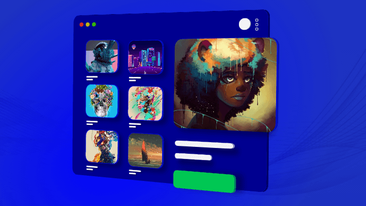With the growing popularity of Non-Fungible Tokens among artists and collectors, NFT marketplaces witness escalating traffic. Top NFT marketplaces such as OpenSea, Axie Infinity, CryptoPunks etc., are in high demand among gamers, digital art collectors, digital subscription models, and fundraising projects.
Businesses consider this huge boom in the NFT marketplace a profitable opportunity for business growth. This article briefs you about the NFT marketplace and will guide you on how to develop your own NFT marketplace as Blaine Graboyes did.
What is an NFT Marketplace?
NFT marketplace is a decentralized platform to assist users in buying, selling and storing NFTs. Blockchain being the fundamental technology of an NFT marketplace, it offers transparency and an immutable register of the tokenization and trading process. It is becoming prominent in various fields of art, entertainment, gaming and even in many Metaverse projects.
However, you have to consider factors like blockchain protocol, NFT storage, architecture designing etc., before going forward with NFT marketplace development.
How does an NFT Marketplace work?
Understanding how the NFT marketplace works from the user end is advised before developing an NFT marketplace. All NFT platforms have an approximately similar workflow.
- A user has to sign up on the platform.
- Install a digital wallet to store NFTs.
- Upload items to create assets. Also, select a preferred payment token and confirm a fee if the platform demands it.
- Now, list items for sale and choose a bid for a fixed price or an auction. During this step, a transaction is generated to launch a personal trading smart contract for the user wallet.
After approval, NFTs will appear on the list.
How to develop an NFT Marketplace?
Step 1: Business analysis
The first step in an NFT marketplace development is making vital decisions and plans, including the features to be executed, which user flow to build etc. A straightforward, feasible and practical marketplace architecture should always be the goal.
Step 2: UI/UX design
A clear and simple user interface without unnecessary elements grabs a user’s attention and can acquire the maximum desired outcome with minimum effort. So, consult a UI/UX design professional for the best result.
Step 3: Smart Contracts protocol development
Smart Contracts are a necessity in NFT marketplace development. Blockchain protocols like Ethereum, solidity and flow are used to create smart contracts based on clients’ requirements.
Step 4: Front-end development
Front-end developers execute all pivotal features on the client-side and implement the best framework for the project so that the platform offers good performance and fast and reliable operations.
Step 5: Testing
Testing the product detects the potential errors helping the developer fix the bug to make it feasible and ready for launch. It is essential to ensure that the project meets the client’s requirements.
Step 6: Launching and support
When the platform is proved to be bug-free, launch the NFT platform. Once it is launched, regular updates and maintenance are required.
Endnote
The constant growth in the NFT trading has increased the demand for a feasible NFT marketplace that enhances the smooth trading of NFT. Popular NFT marketplaces like the OpenSea or Rarible have people flocking for NFT trading. Entrepreneurs and businesses use this opportunity to build their marketplaces to capitalize on this new technology. With NFTs being unique and rare, most industries want to develop their own NFT marketplaces to represent a more significant part of the digital economy in the future.













